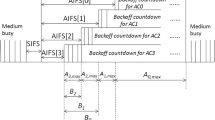Abstract
The IEEE 802.11e EDCA is designed to provide quality of support for real time applications with stringent latency and throughput requirements. Theoretical frameworks for analysis of throughput performance of wireless LAN employing exponential back-off exist extensively. Several models rely on simplification assumptions that preclude their direct applicability to the enhanced distributed coordination access (EDCA) which uses heterogeneous protocol parameters, while other models are exceedingly complex to analyze. In this paper, a tractable analytical model is proposed for saturation throughput of the IEEE 802.11e EDCA. The prioritization through channel access parameters including the AIFS and contention window is catered for within a three dimensional Markov chain. The integration of back-off counter freezing and retry limit enhance the models precision. Its validation is done by simulation on NS-2. Practical applicability of the model is established based on accuracy and computational efficiency. The model is utilized for throughput analysis of the EDCA under saturated traffic loads.









Similar content being viewed by others
Abbreviations
- \(a_{i,j}^{k}\) :
-
Steady state probability of the state representing back-off stage \(i\), back-off counter \(j\), and previously sensed medium state \(k\)
- \(CW_{max}\) :
-
Maximum contention window size
- \(CW_{min}\) :
-
Minimum contention window size
- \(m\) :
-
Maximum back-off stage after which the value of contention window is not increased
- \(n_{h}\) :
-
Number of contending higher priority flows
- \(n_{l}\) :
-
Number of contending lower priority flows
- \(p_{0}\) :
-
Probability that the medium is busy after after an idle slot
- \(p_{1}\) :
-
Probability that the medium is busy after after a busy slot
- \(P_{c}\) :
-
Probability that a given time slot contains a collision
- \(P_{i}\) :
-
Probability that a given time slot is idle
- \(P_{s}\) :
-
Probability of a successful transmission in a time slot
- \(PL\) :
-
Length of payload in bits
- \(r\) :
-
Retry limit
- \(S\) :
-
Saturation throughput
- \(TXOP\) :
-
Transmission opportunity
- \(T_{c}\) :
-
Time spent due to a collision
- \(T_{s}\) :
-
Time spent due to a successful transmission
- \(W_{i}\) :
-
Back-off window at the \(ith\) back-off stage
- \(\sigma\) :
-
Time slot duration
- \(\tau _{0}^{h}\) :
-
Probability that a higher priority flow accesses the medium after a busy slot
- \(\tau _{1}^{h}\) :
-
Probability of medium access by a lower priority flow
References
(2005) IEEE Std. 802.11e-2005, Part 11: Wireless LAN Medium Access Control (MAC) and Physical Layer (PHY) specifications, Amendment 8: Medium Access Control (MAC) Quality of Service Enhancements. Tech. rep.
Ansel P, Ni Q, Turletti T (2004) An efficient scheduling scheme for IEEE 802.11 e. In: Proc. Modeling and Optimization in Mobile, Ad Hoc and Wireless Networks, pp 24–26.
Bianchi G (2000), Performance analysis of the IEEE 802.11 distributed coordination function. IEEE Journal on Selected Areas in Communications 18(3):535–547.
Foh CH, Tantra JW (2005), Comments on IEEE 802.11 saturation throughput analysis with freezing of backoff counters. IEEE Communications Letters 9(2):130–132.
Gas M, Kosek-Szott K, Natkaniec M, Pach A (2011), 3D Markov chain-based saturation throughput model of IEEE 802.11 EDCA. Electronics letters 47(14):826–827.
Huang CL, Liao W (2007) Throughput and delay performance of ieee 802.11 e enhanced distributed channel access (edca) under saturation condition. Wireless Communications, IEEE Transactions on 6(1):136–145.
Inan I, Keceli F, Ayanoglu E (2007a) Modeling the 802.11 e enhanced distributed channel access function. In: Global Telecommunications Conference, 2007. GLOBECOM’07. IEEE, IEEE, pp 2546–2551.
Inan I, Keceli F, Ayanoglu E (2007b) Performance analysis of the ieee 802.11 e enhanced distributed coordination function using cycle time approach. In: Global Telecommunications Conference, 2007. GLOBECOM’07. IEEE, IEEE, pp 2552–2557.
Jacques I, Judd C (1987) Numerical Analysis. Chapman and Hall: London.
Lee JY, Lee HS (2009), A performance analysis model for IEEE 802.11 e EDCA under saturation condition. IEEE Transactions on Communications 57(1):56–63.
Lin Y, Wong VW (2006) Saturation throughput of ieee 802.11 e edca based on mean value analysis. In: Wireless Communications and Networking Conference, 2006. WCNC 2006. IEEE, IEEE, vol 1, pp 475–480.
Taher NC, Doudane YG, El Hassan B (2009a) A complete and accurate analytical model for 802.11 e edca under saturation conditions. In: Computer Systems and Applications, 2009. AICCSA 2009. IEEE/ACS International Conference on, IEEE, pp 800–807.
Taher NC, Doudane YG, El Hassan B, Agoulmine N (2009b) First step towards an efficient admission control: A complete analytical model for 802.11 e EDCA for throughput and delay prediction. In: IM’09. IFIP/IEEE International Symposium onIntegrated Network Management-Workshops, 2009, IEEE, pp 217–224.
Tantra JW, Foh CH, Mnaouer AB (2005) Throughput and delay analysis of the IEEE 802.11 e EDCA saturation. In: ICC 2005. 2005 IEEE International Conference on Communications, 2005, IEEE, vol 5, pp 3450–3454.
Xiao Y (2004) Performance analysis of IEEE 802.11 e EDCF under saturation condition. In: 2004 IEEE International Conference on Communications, IEEE, vol 1, pp 170–174.
Yan Y, Pan C (2007) An improved analytical model for ieee802. 11e enhanced distributed channel access. In: Information Technology Convergence, 2007. ISITC 2007. International Symposium on, IEEE, pp 135–142.
Author information
Authors and Affiliations
Corresponding author
Rights and permissions
About this article
Cite this article
Usman, M.F., Hussain, A. & Nadeem, F. Saturation Throughput Analysis of IEEE 802.11e EDCA Through Analytical Model. Int J Wireless Inf Networks 21, 101–113 (2014). https://doi.org/10.1007/s10776-014-0238-8
Received:
Accepted:
Published:
Issue Date:
DOI: https://doi.org/10.1007/s10776-014-0238-8




